Complete Solutions to Organisms And Population of chapter ORGANISMS AND POPULATION of Class 12 book with complete answers and questions
| Class 12 | BIOLOGY |
| Chapter | ORGANISMS AND POPULATION |
| NCERT FINGERTIPS | Organisms And Population |
| Number Of Questions | 100 |
| Academic Year | 2023-24 |
Refer to the given flow chart.

Identify `X` and select the correct option.02:36View SolutionBasic unit of ecological hierarchy is
03:15View SolutionSeveral plant and animal species present together at a place constitute a
02:46View SolutionThe branch of science which studies the ineractions among organisms and between organisms and physical environment is called as
04:23View SolutionNiche overlap indicates
04:37View SolutionRead the given statements and select the correct option.
Statement 1 : Cow in india and Kangaroo in Australlia (both herbivores) are ecological equivalents.
Statement 2: The organisms having smallar niche in different geographical regions are known as ecological equivalents.03:45View SolutionRead the given statements and select the correct option.
Statement 1 : Study of a single individual or a population in relation to environment is called autecology.
Statement 2 : Study of group of individuals or a community in relation to environment is known as synecology.03:46View SolutionSeasonal variations on Earth occur due to its
03:33View SolutionIn the given figurem identify the temperate forest and coniferous forest respectively from the markings `A-F` and select the correct option.
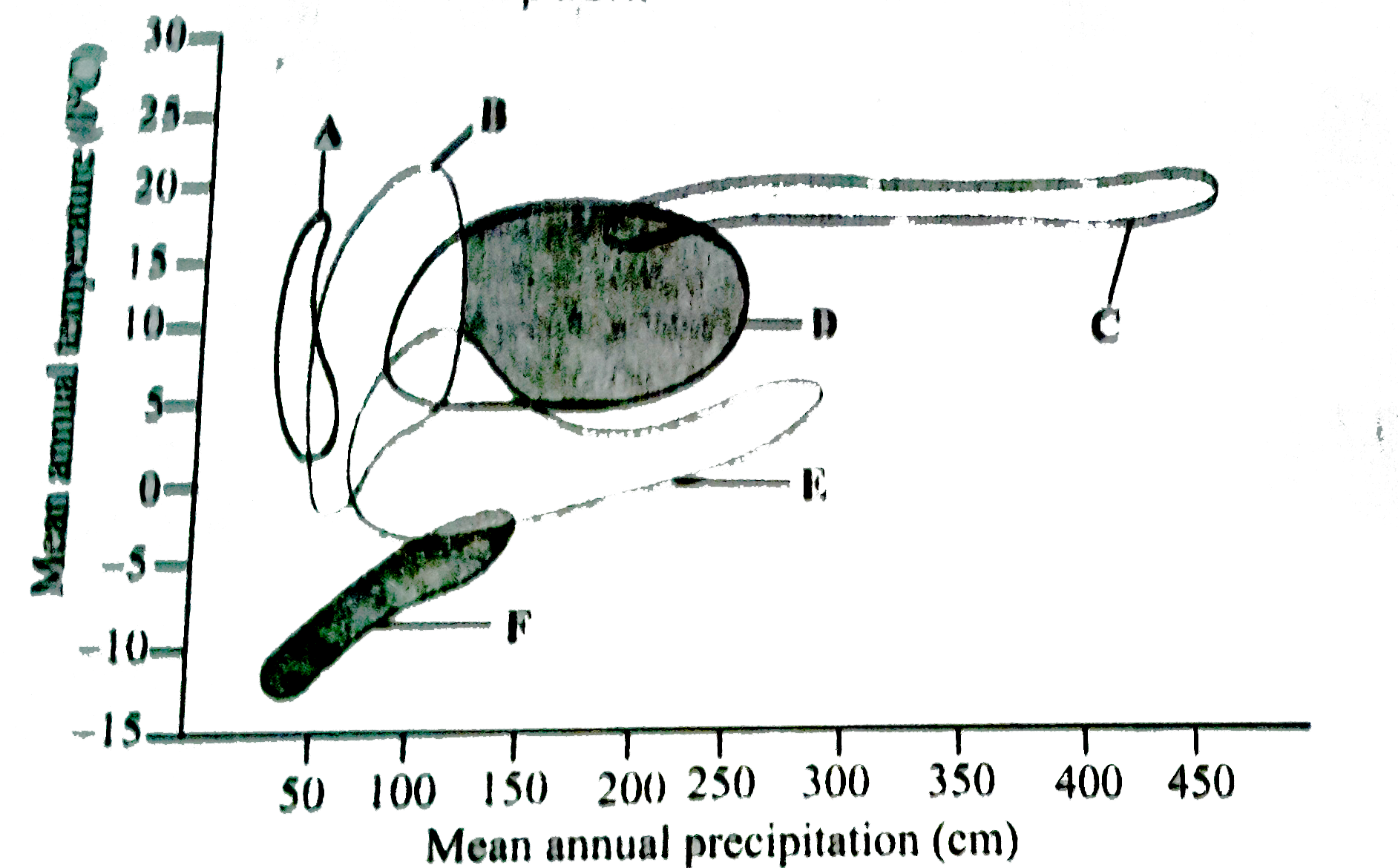 03:03View Solution
03:03View SolutionDifferent biomes are formed due to annual variations in ________over the earth's surface.
04:18View SolutionDeserts, rain-forest, tundra etc, are examples of
02:40View SolutionCharacteristics of a terrestrial biome are strongly influence by its
03:48View Solution________occurs in equatorial regions where rainfall and warmth are abundant, while________biomes lacks rain.
02:09View SolutionIf `A,B,C,D, G,P,Q,R` and S represent different species then which of the following figures symbolizes a biome ?
05:19View SolutionThe key elements that determine differences in environmental conditions of different habiats include
04:40View SolutionWhich of the following is not a part of an organism's physical environment ?
02:50View SolutionWhich of the following statements is incorrect ?
03:53View SolutionMango trees do not and cannot grow in temperate regions. The most important environmental factor responsible for its is
03:23View SolutionTemperature is considered as the most ecologically relevant environmental factor because it affects or organisms.
01:46View SolutionStudy the following statements and select the correct ones.
(i) Organisms capable to tolerate a wide range of temperature are called stenothermal organisms.
(ii) Thermal tolerance of different species determine their grographical distribution to a large extent
(iii) Avarge temperature in tropical deserts in summer is `lt 50^(@)C`.
(iv) Thermal springs cannot sustain life due to very high average temperature i.e., `gt 100^(@)C`.04:30View SolutionWhich of the following options is correct ?
03:34View SolutionWater is the second most important factor influencing life of organisms because
03:31View SolutionOrganisms that can tolerate a wide range of salt concentration are termed as
03:03View SolutionA freshwater organism cannot survive in a water body that has greater _____than its original habitat.
04:08View SolutionLife is sustainable with water only because
04:46View SolutionA place has very scanty rainfall, the dominant plants there mat be
02:47View SolutionMany freshwater organisms cannot live for long in seawater because the surrounding water will be_______to body cells and _______may occur.
03:04View SolutionThree water bodies were tested for salinity of water. Water body `X` showed salt concentration as 3 parts per thousand `Y` showed 35 parts per thousand and `Z` showed 110 parts per thousand salinity.
05:13View SolutionGiven figure represents the different zones of a lake or a pond.
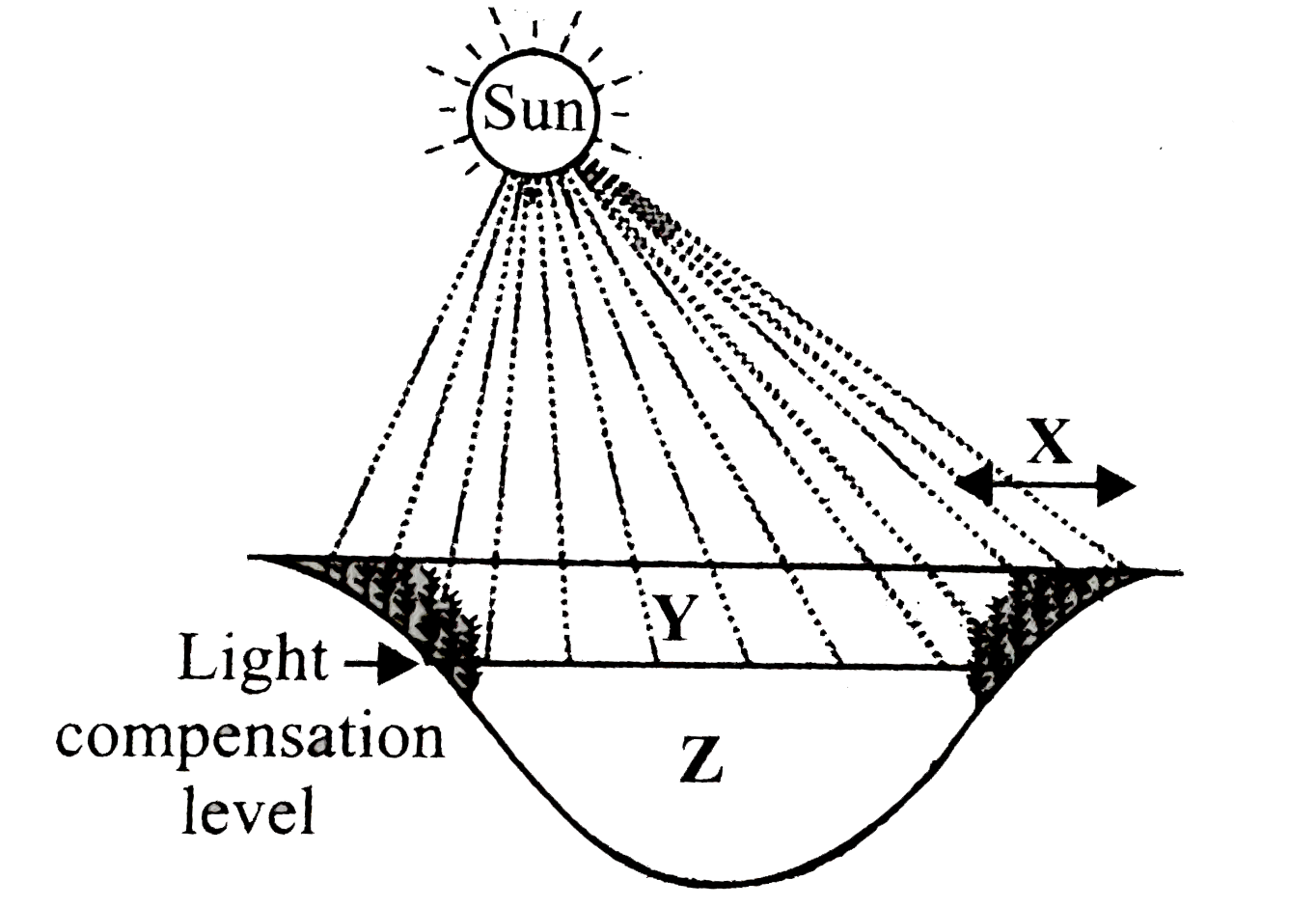
Identify the labelled parts `X,Y` and `Z` and select the correct statement.03:33View SolutionMany animals use the diurnal and seasonal variations in light intensity and photoperiod to time their
05:04View SolutionNature and proerties of soil depends upon
03:33View SolutionWater holding capacity of the soil depends upon
04:06View SolutionWhich of the following statements is incorrect ?
05:09View SolutionRead the following statements and select the correct ones.
(i) All the colour components of the visible spectrum are available for marine plants living in different depths of the ocean.
(ii) Many herbs and shurbs in rainforests adapt to photosynthesise optimally under very low light conditions as they grow under canopy trees
(iii) Gradual increas in average global temperature will affect the distributional range of some species.
(iv) The quality of soil does not depend upon the weathering process.05:46View SolutionGiven figure represents the soil profile, showing different layers/horizons of soil. Which of the following statements regarding the soil profile are not true ?

(i) Maximum roots of plants are found in horizon `A`.
(ii) Maximum nutrients are present in horizon `B`.
(iii) Horizon `B` contains partly weathered rocks.
(iv) Horizon `C` contains roots of the plants and mineral salts.03:48View SolutionAn animal that can survive at `10^(@)C` and `40^(@)C` both, can be placed under the category of
02:42View SolutionGiven graph represents the response of organisms to various abiotic factors. On this basis, select the correct option for (i), (ii) and(iii)
 06:52View Solution
06:52View SolutionThe given graph represents how three different living organisms (X,Y and Z) cope with the external environmental conditions. Study the graph and select the correct option regarding X,Y and Z.
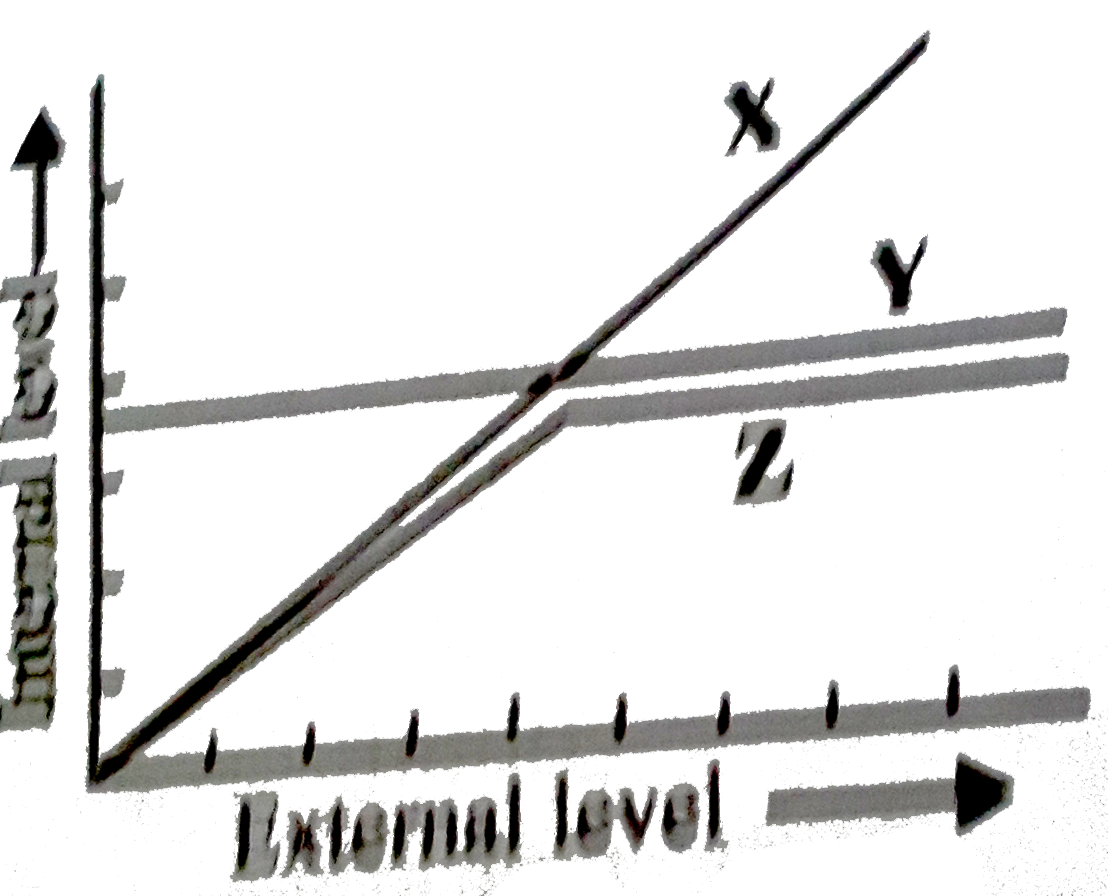 04:33View Solution
04:33View SolutionOrganisms that can maintain a constant internal temperature are called as
03:50View SolutionWhen we are in a hot room, we sweat profuselt. It is a __________means of maintaining homeostasis.
02:36View SolutionRead the following statemetns and select the incorrect ones.
(i) Homeostasis constant osmotic concentration of cells.
(ii) The famous keoladeo National Park (Bharapur) in Rajasthan hosts thousands of migratory birds coming from Siberia, in every winter.
(iii) `99%` of animals and nearly all plants are regulators.
(iv) The conformers are able to maintain their body temperature inspite of changes in ambient temperature.05:43View SolutionWhich of the following statements is incorrect ?
03:54View SolutionIt can be said that some animals in their evoluationary development preferred to be conformers than regulators. Which of the following can be best suited reason for it?
03:54View SolutionWhich of the following options is correct ?
04:30View SolutionVery small animals are rerely found in polar regions because
03:52View SolutionWhich of the following is an important adaptation of animals to the cold climate ?
03:11View SolutionAssuming that an animal generates heat at a rate proportional to its volume and can radiate heat at a rate proportional to its body surface area, which of the following would be best at maintaing its body temperature in a cold climate ?
03:02View SolutionWhen organisms change their location to escape from harsh environment, it is called as
03:53View SolutionOrganisms show migration in order to avoid unfavourable conditions of
02:41View SolutionOrganisms may avoid stressful conditions by suspending their activities for sometime. If they do it to aviod high temperature it is called ________and if they do it to avoid low temperature then it is called _________
03:21View SolutionWhich of the following is an incorrect match ?
02:34View SolutionMatch column I with column II and select the correct option from the given codes.
`{:(Column I, ColumnII),(A."Eurtythermal",(i)"Able to tolerate narrow range of temperature"),(B."Stenothermal",(ii)"A stage of suspended development"),(C."Conformers",(iii)"Body temperature changes with ambient temperature"),(D."Diapause",(iv)"Able to tolerate wide range of temperature"):}`02:47View SolutionAdaptation may be
02:17View Solution_____________is an attribute of the organism (morphological, physiological, behavioural) to survive and reporudce in its habitat.
03:17View SolutionKangaroo and desert rat that live in conditions of water scarcity are capable of meeting all their water requirements by
03:52View SolutionRead the following statements about adaptations in desert plants and select the correct ones.
(i) They have a thick cuticle on their leaf surfaces.
(ii) They have stomate present in deep sunken pits.
(iii) They use CAM pathway for photosynthesis.
(iv) They have flattened stems and large sized leaves.
(v) Their stomata remain closed during the day.04:31View SolutionOpuntia has spine like leaves which help in
02:12View Solution________rule states that mammals from colder climates generally have shorter ears and limbs to minimise heat loss.
01:55View SolutionAn inhabitant of Varanasi goes to Rohtang and experiences nausea, fatigue and heart palpitations. It is because
03:02View SolutionArchaebacteria that flourish in temperature above `100^(@)C` have special_________molecules that do not coagulate at high temperature and remain functional.
01:51View SolutionWhich of the following problems does the frequent deep ears diver organisms like whales may face ?
03:00View SolutionIce fish and Antartic fish remain active in extremely cold water due to
02:44View SolutionWhich of the following statements is correct with regard to Bergmann's rule?
03:25View SolutionWhich of the following options exemplifies a behavioural means of homeostasis ?
02:12View SolutionA behavioural strategy of adaptation called echolocation is found in
02:23View SolutionIf a organism's body pattern resembles its environment making it difficult to spot, it is called as
02:40View SolutionDart frogs (Phyllobates bicolour, Dendrobates pumilo) found in tropical rain forests of South America are highly poisonous as well as brightly coloured to be easily notice. This is referred to as
04:15View SolutionMatch column I with column II and select the cirrect option from the given codes.
`{:(Column I, Column II),(A."An endothermic animal",(i)"Sea anemone"),(B."An ectothermic animal",(ii)"Man"),(C."Organism of benthic zone",(iii)"Lizard"),(D."An organism exhibiting camouflage",(iv)"Chameleon"):}`03:40View SolutionPopulation ecology is an important area because it `ul((i))` ecology to population genetics and `ul((ii))`. Identify (i) and (ii) in the above statement and select the correct option.
02:58View SolutionIn a pound, last year there were 30 ltus plants. Through reproduction, 25 new lotus plants were added in one year while 8 plants died. The birth and death rates for the lotus population respectively are _______and _____individulas per lotus per year.
04:17View SolutionParameters related to age structure include
02:23View SolutionIn a life table, the number of individuals alive at the beginning of the `1^(st)` year interval is 800. During this interval, 200 individuals die. The death rate for this interval is
02:27View SolutionPercentage of individuals of a given age group in a given population is called as
02:25View SolutionIf the age distribution is plotted for a population, the resulting structure is called as
03:43View SolutionWhat does the shape of the given age pyramids reflects about the growth status of the related population ?
 04:09View Solution
04:09View SolutionA population in which number of pre-reproductive individuals is very large, number of reproductive individuals is moderate while post-reproductive individuals are fewer. Which kind of age pyramid is represented by such a population ?
04:31View SolutionWhat does the shape of the given age pyramids (A to C) reflect about the growth status of populations ?
 03:57View Solution
03:57View SolutionThe age structures of a population represents
02:53View SolutionThe age structures of a population influences population growth because
03:48View SolutionIf most individuals in a population are young, why is the population likely to grow rapidly in the further ?
02:12View SolutionStudy the age pyramids given below and select the correct statements regarding these.
 06:02View Solution
06:02View SolutionA population with a larger proportion of older individuals than younger ones will likely to
02:30View SolutionAn urn shaped population age pyramid represents
04:19View SolutionGiven figures represent comparative age-sex pyramids for India for the years 1971 (figure A ) and 1991 (figure B), over the 20-year period. Study carefully the pyramids and select the correct statement regarding these.
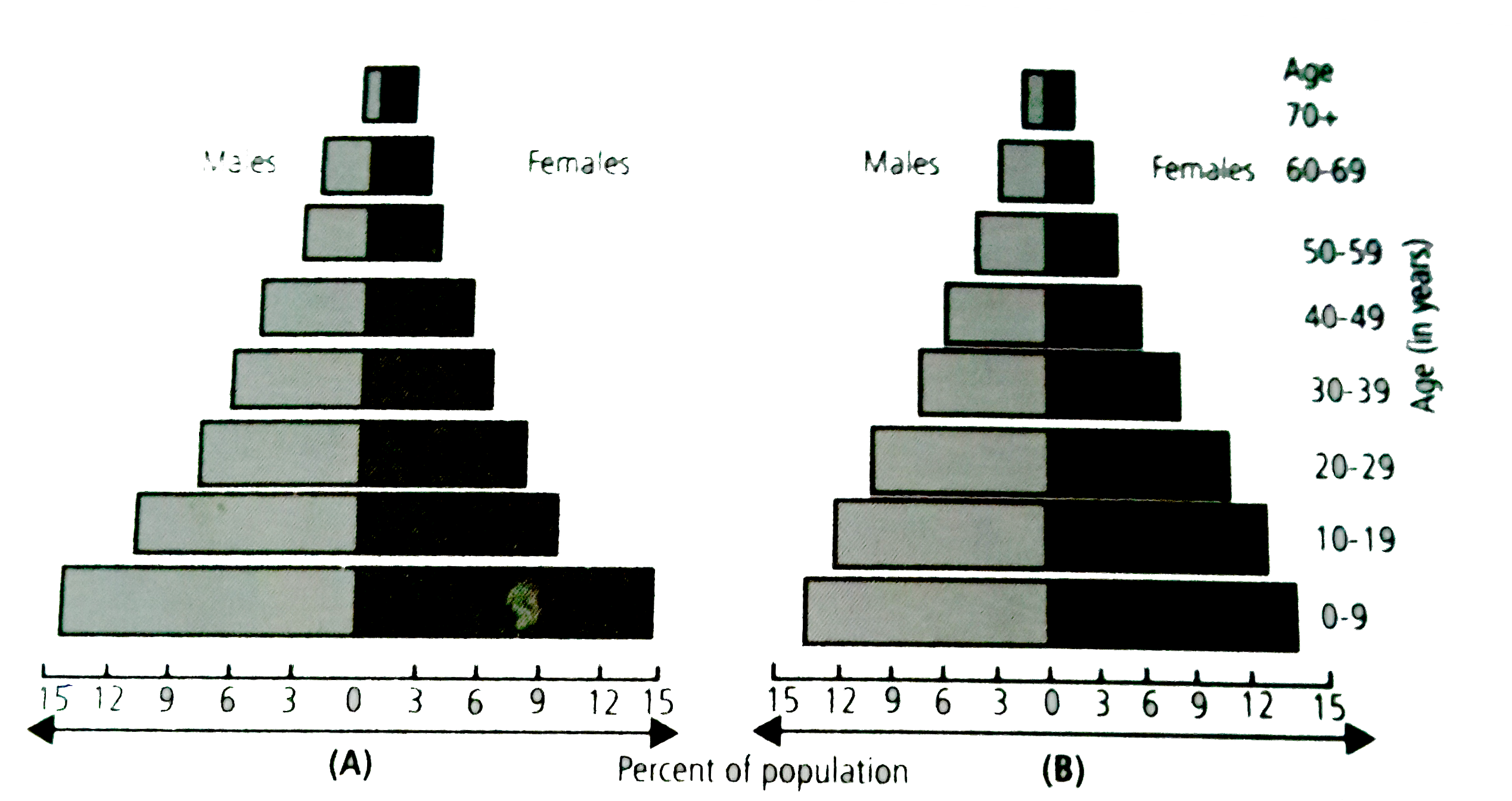 04:07View Solution
04:07View SolutionAge-sex sturcture of a population can be depicted in the form of a pyramid by plotting the percentage of population of each sex in each age class. Two age sex pyramids are given here.

Study carefully the above age-sex pyramids and select the correct statements regarding these.04:09View SolutionIn a given population of 2000 indivials, 80 births and 125 deaths were reported over a given period of time. Which of the following graphs will correspond to it ?
02:53View SolutionTotal number of individuals of a species per unti area and per unit time is called
02:51View SolutionIn some cases, population density is measured in terms of biomass rather than in terms of number because
04:06View SolutionWhich of the followinf is not an example of using relative density to measure population density in a certain area ?
03:44View SolutionFor which of the following cases, population density can be easily determined by utilising non-biological parameter ?
01:51View SolutionThe given figure represents different factors affecting population density `(N)`. If `B =` natality `D =` mortality ,`E =`emigration and `I = ` immigration, then select the incorrect option regarding these.
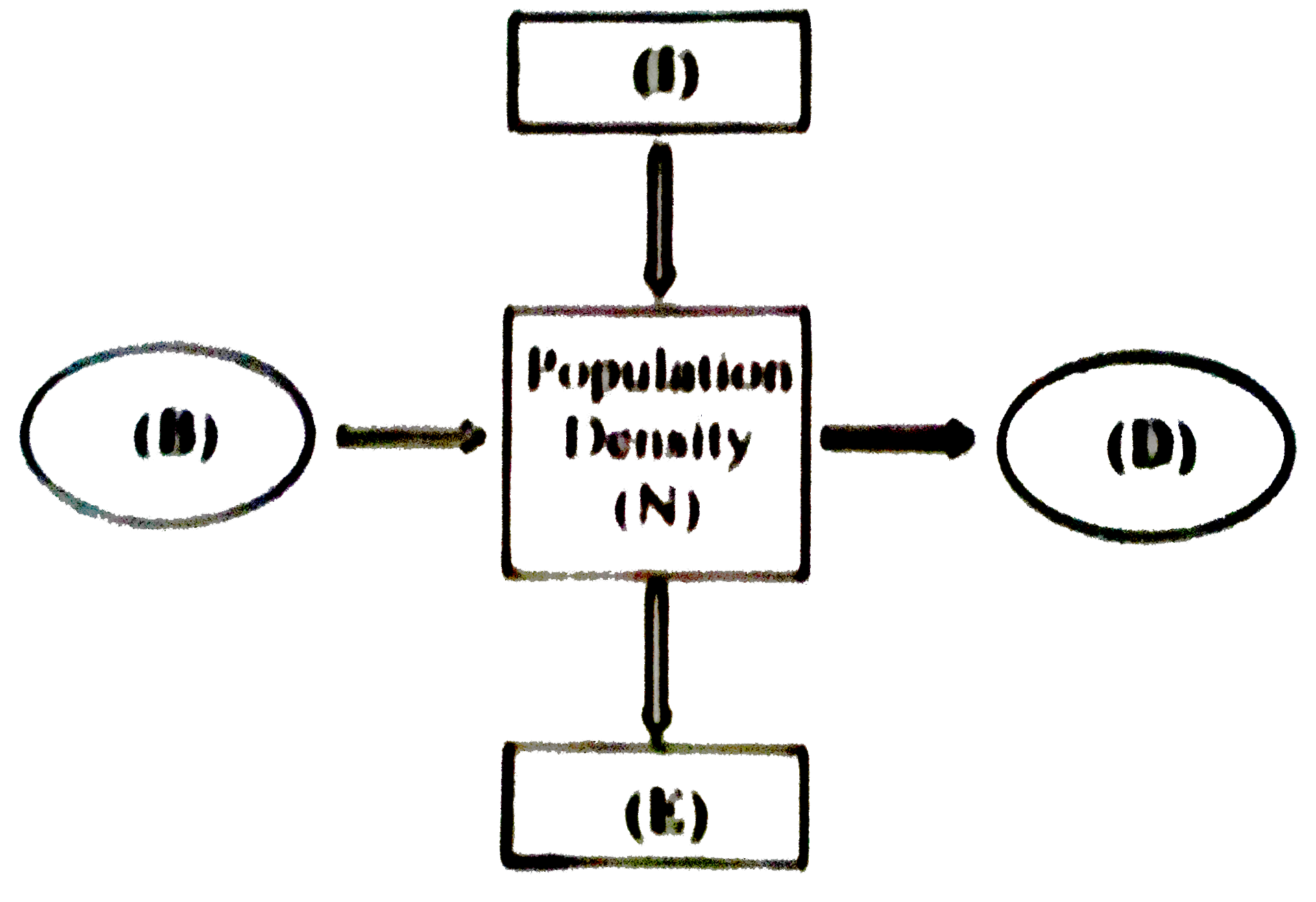 04:26View Solution
04:26View SolutionThe density of a population in a given habit during a given period, fluctuates due to changes in certain basic processes. On this basis, fill up boxes `A` and `B` in the given flow chart with correct option.
 03:17View Solution
03:17View SolutionWhich of the following is not a factor that would limit the growth of a population ?
02:54View SolutionFollowing table summarises the differences between natality and mortality. Select the incorrect ones.
`{:("Natality","Mortality"),((i)"Natality is number of births per unit population per unit time.","It is number of deaths per unit population per unit time."),((ii)"It adds new individuals to the population.","It removes individuals from the population"),((iii)"It increase the size of population.","It decreases the size of population"),((iv)"It increase population density.","It reduces population density."),((v)"It is low when population size is small and high when population size is large.","It is high when population size is small and low when population size is large."):}`04:04View SolutionWhich of the following factors has a negative effect on the population growth rate ?
02:15View SolutionIf `N =` population density at time t, then population density at time `t + 1` can be written as. `N_(t+1) = N_(t) + [(A+B)-(C+D)]`. Select the correct option for `A,B,C` and `D` in the above equation.
03:08View SolutionWhich of the following factors influence population density under normal conditions ?
02:41View SolutionWhich of the following statements is/are incorrect ?
02:55View SolutionExponential growth is observed in a population when
03:20View SolutionIn a population per capita birth rate is `0.15` and per capita death rate is `0.08` during a unit time period. What is the value of r (intrinsic rate of natural increases) for the given population ?
02:25View Solution
Organisms And Population questions and complete solutions for chapter ORGANISMS AND POPULATION of MTG BIOLOGY (HINGLISH) of Class 12
